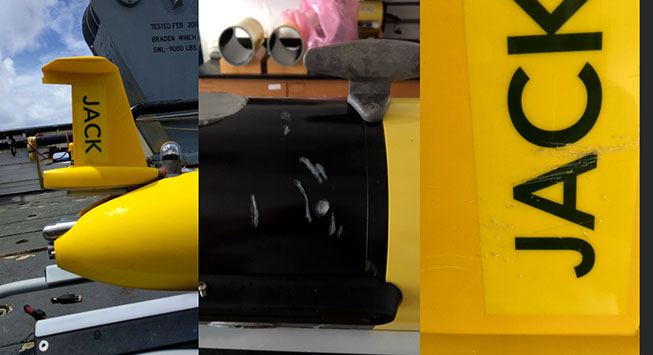A Shark Attack on Glider Jack

Not long after sunrise on July 24, a BIOS-operated ocean glider named Jack climbed slowly from a depth of nearly a half-mile offshore Bermuda toward the sea surface as it’s sensors collected and measured ocean properties, including temperature, salinity, oxygen, chlorophyll, and currents. It was a routine operation for Jack, an airplane-shaped vehicle that has traveled a similar path thousands of times over the past two years for BIOS researchers in the Sargasso Sea.
But on this morning, it had a hungry companion. Though no one ever saw the shark, BIOS physical oceanographer Ruth Curry described it as “likely large, judging by the force of its impact on the glider and the bite marks on the remains of Jack’s tail.”
Jack doesn’t carry a camera among its payload of sensors, but it does routinely send data—including its location—via satellite to Curry, who pilots the glider (and two others) by computer from BIOS. When Jack began to drift off its programmed course, it became obvious to her that something was wrong. As the vehicle continued to send its position, moving northward with the currents instead of southeast toward the waypoint Curry had given it, she arranged for the BIOS-operated vessel Atlantic Explorer to collect the glider, then about 50 miles (80 kilometers) from Bermuda.

After crew members on the Atlantic Explorer recovered the BIOS-operated glider Jack in late July (left photo), they found that most of the glider’s rudder was missing and the horizontal tail boom was wrenched upward by about five degrees, leaving Jack unable to steer. Back at BIOS, researchers applied nail polish to fill in scratches from the shark’s teeth (center photo). Physical oceanographer Ruth Curry, who operates the glider program at BIOS, called the bite marks and gouges (right) on the glider’s tail impressive because “it’s really difficult to scratch that carbon fiber material!”
Four days later, with Jack back at BIOS, Curry began piecing together what happened. Most of the glider’s rudder was missing and the horizontal tail boom was wrenched upward by about five degrees, leaving Jack unable to steer. Based on the vehicle’s recorded pitch, roll, heading, and pressure measurements, Curry was able to pinpoint the date and time of the attack (7:17 am), as well as the vehicle’s depth during the encounter (682 meters, or just under a half mile).
The attack was a first for any of the three gliders Curry operates at BIOS through the Institute’s MAGIC Lab (for Mid-Atlantic Glider Initiative and Collaboration). But it’s not unheard of for sharks to chomp down on robotic vehicles, which they may mistake for food. In 2013, scientists at Woods Hole Oceanographic Institution used a REMUS SharkCam glider to track and film sharks offshore Mexico. Their glider included six mounted cameras, which recorded dozens of shark bumps and bites. The bumps were thought to constitute aggressive behavior consisting of brief physical contact, usually with the shark nudging the vehicle with its snout, the scientists and WHOI reported. The bites, which usually happened toward the rear of the vehicle, were interpreted as predatory behavior by the animal.
Jack is now back in the water—still bearing scars from the bite, but sporting a new tail rudder. Researchers are using the glider’s data to study the processes controlling biological productivity, monitor upper ocean temperatures, and measure the impact of intense storms and hurricanes (a more worrisome and likely threat to Bermudians than sharks this time of year).
“We were able to fix the tail and send Jack to profile the ocean 50 miles offshore again,” Curry said. “The glider is ready for hurricane duty if the situation should arise.”
